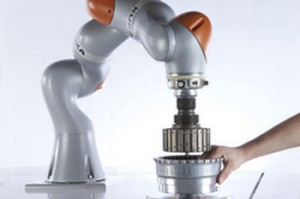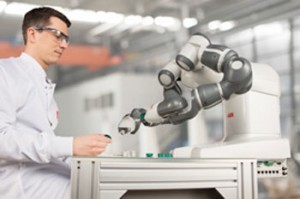AUTOMATICA 2016 – Breakthrough of smart robots
 Robots have left their protective cage. They now work closely with people. AUTOMATICA (Munich 21-24 June, 2016) will highlight how the automation industry is facing the challenge of this new technology.
Robots have left their protective cage. They now work closely with people. AUTOMATICA (Munich 21-24 June, 2016) will highlight how the automation industry is facing the challenge of this new technology.
Pictured right: Safe collaboration of humans and robots, without a safety barrier. The lightweight LBR iiwa from KUKA makes it possible.
Clever, lightweight robot arms are faithful helpers in production, especially where the high productivity of a robot can be combined with the sensory and cognitive capabilities of people. They relieve people of monotonous or heavy work and consequently ensure better health and quality of life. “The borders between industrial and service robotics are merging,” asserts Wilfried Eberhardt, chief marketing officer at KUKA AG.
Smart robots belong to the factory of the future in this context. “A technology transfer is taking place, which opens up new application possibilities,” he continues.
Regardless of whether the LBR iiwa from KUKA, YuMi from ABB robotics or the service robots from PAL Robotics and Rethink Robotics, conventional industrial robots manufacturers as well as service robotics companies and new players in the market provide marketable solutions for the interaction between humans and robots.
Service robotics in the core of Industry 4.0
The fourth industrial revolution has begun with a networked production world that can react flexibly and fully automated to changing needs. Robots, which are mobile and collaborate with people, are indispensable in this. Industry 4.0 and the resulting applications are a chance to establish Europe as a technology leader and pioneer.
 An important milestone here is human-robot collaboration that ensures workplace ergonomics and better working conditions. Service robotics applications can help to master the challenges of an aging society.
An important milestone here is human-robot collaboration that ensures workplace ergonomics and better working conditions. Service robotics applications can help to master the challenges of an aging society.
Pictured left: With YuMi, ABB is opening a up new era in which humans and robots collaborate safely without protective devices.
Intelligent service robots have become part of everyday life. They assume complex tasks, which could not be automated previously, with high precision and high quality. They can be programmed and are capable of learning. As a result, they are used in very different projects, which increases productivity. Thanks to stereo vision and 3D sensors, robots can scan their environment and consequently make elaborate security barriers superfluous.
Connected to the environment via sensors and actuators, robots become cyber-physical systems (CPS), which are being networked increasingly with each other and with the Internet. The Internet of Things (IoT) will network all devices and robots of an automated production chain regardless of location in the future.
Lucrative future potential for Europe
According to the International Federation of Robotics (IFR), the market for professional service robotics will continue to grow tremendously. About 150,000 units are expected to be sold by 2018, thereby providing sales of approx. 20 billion US dollars. The growth rate in this area was a solid 11.5% last year alone. The most important applications in the civilian sector are agriculture, logistics and medicine.
Henrik Schunk, managing director of Schunk, states it succinctly: “Service robotics is in the middle of implementation. It has the potential to drive the Industrial Revolution forward to an incredible degree.”
AUTOMATICA 2016 will present the latest developments at the interface between industrial and professional service robotics. The human-robot collaboration and technological synergies between industrial and service robotics are the focus.
Visit the AUTOMATICA website for more information.
See all stories for AUTOMATICA















